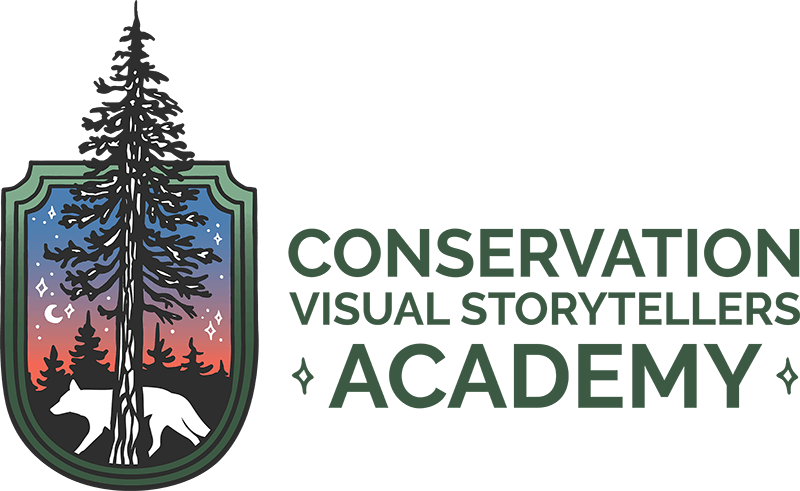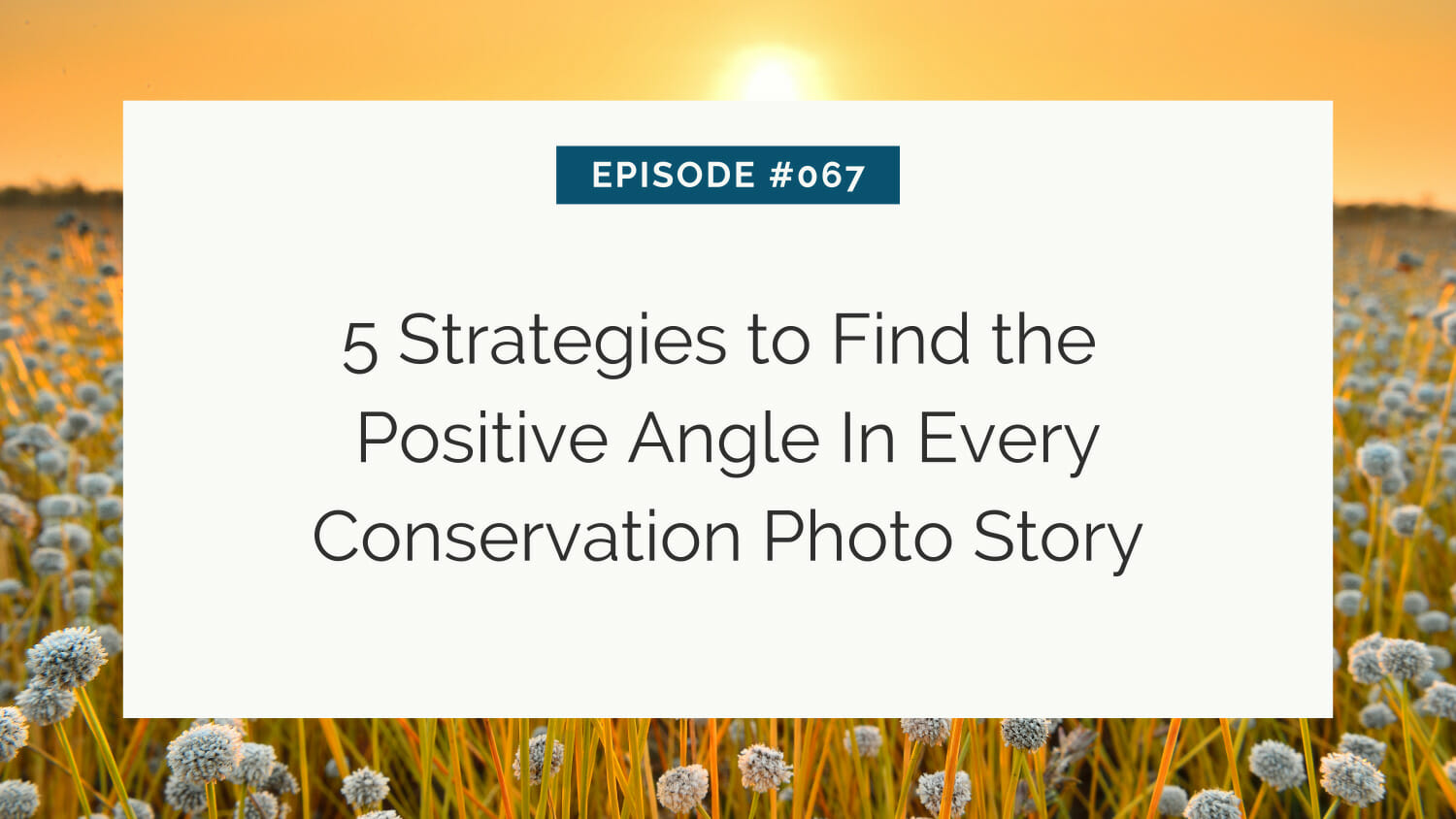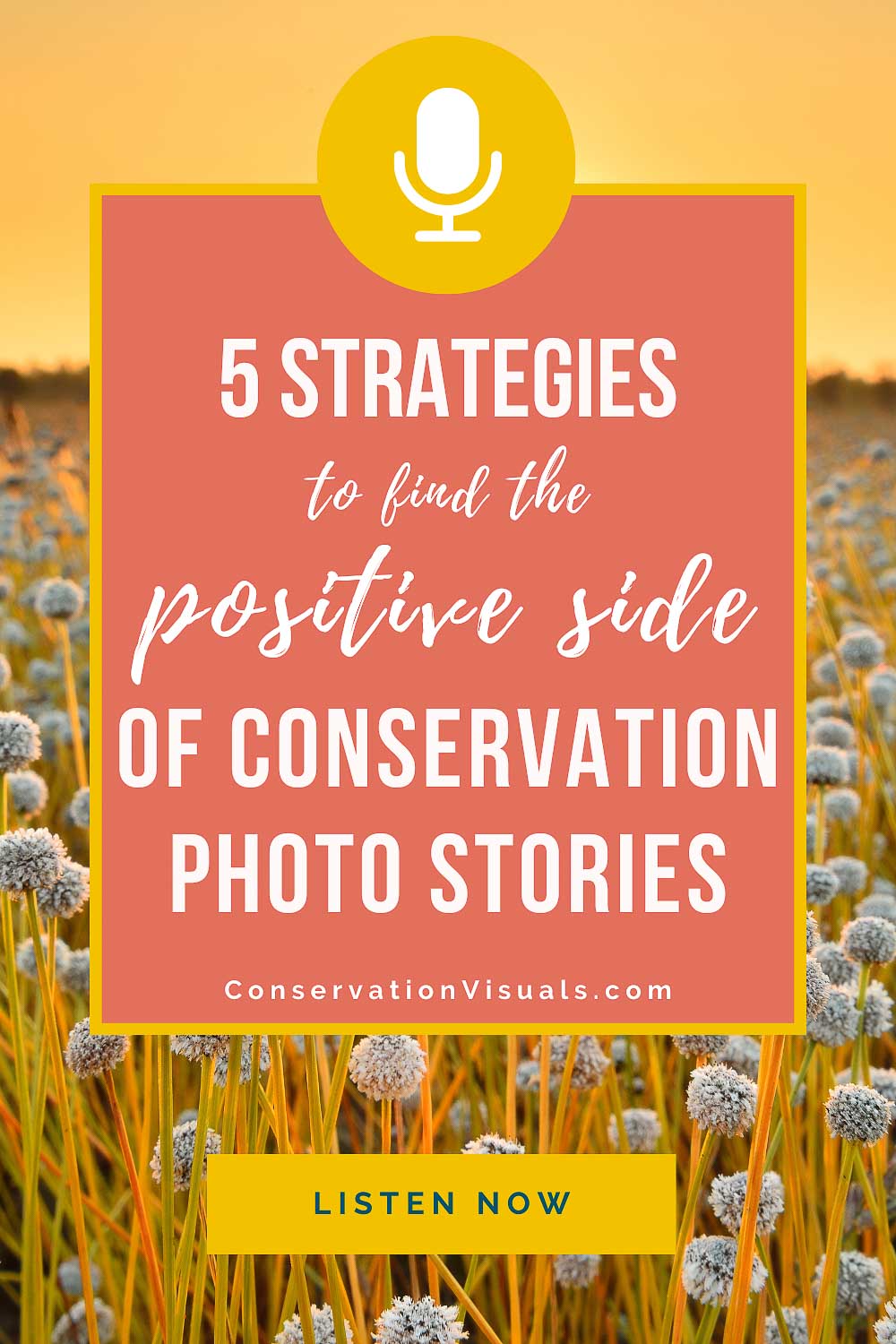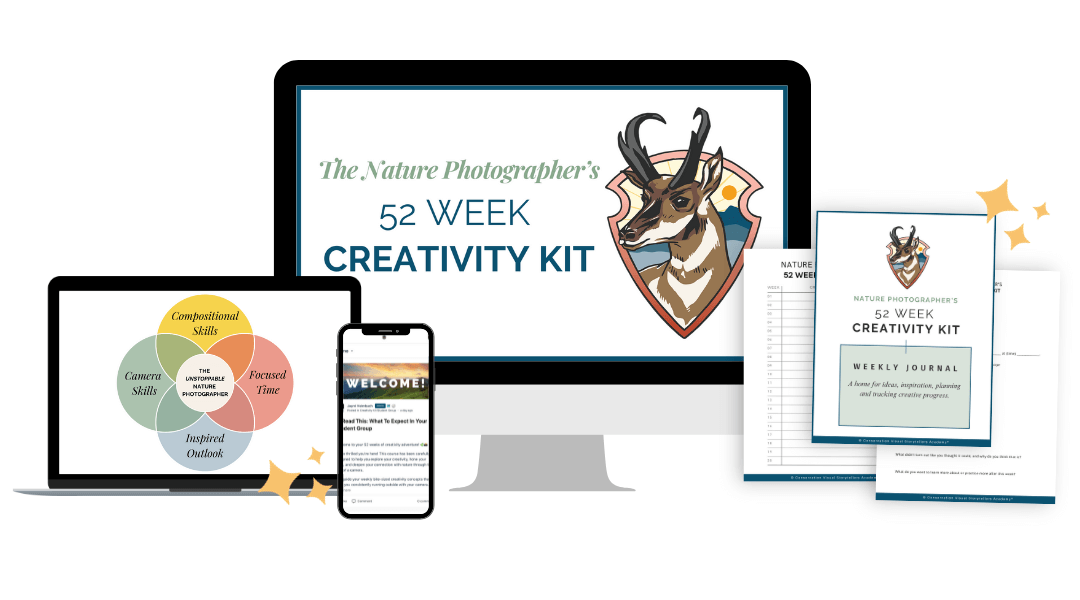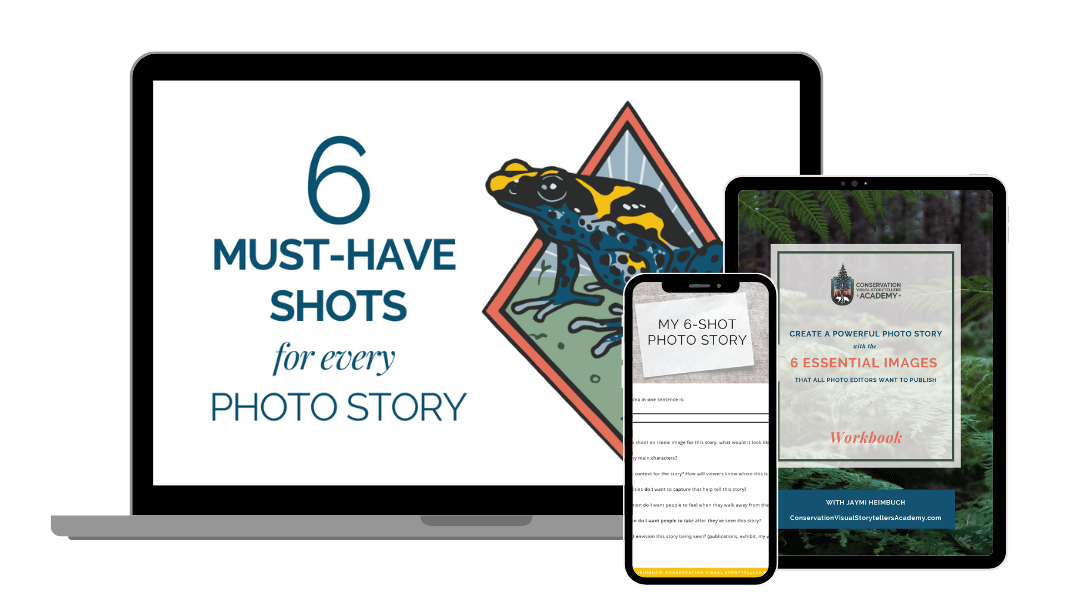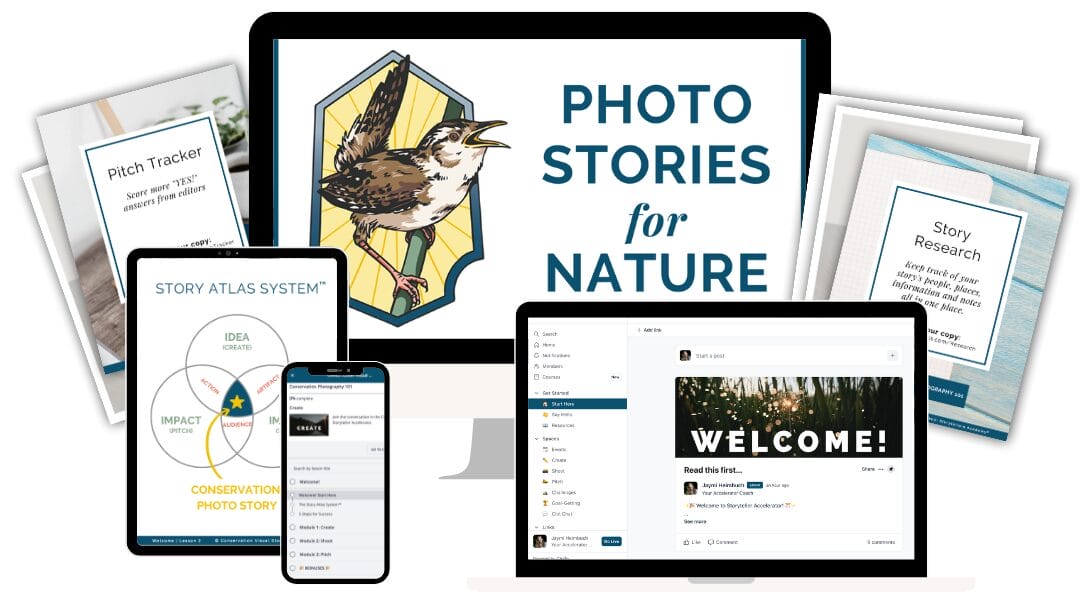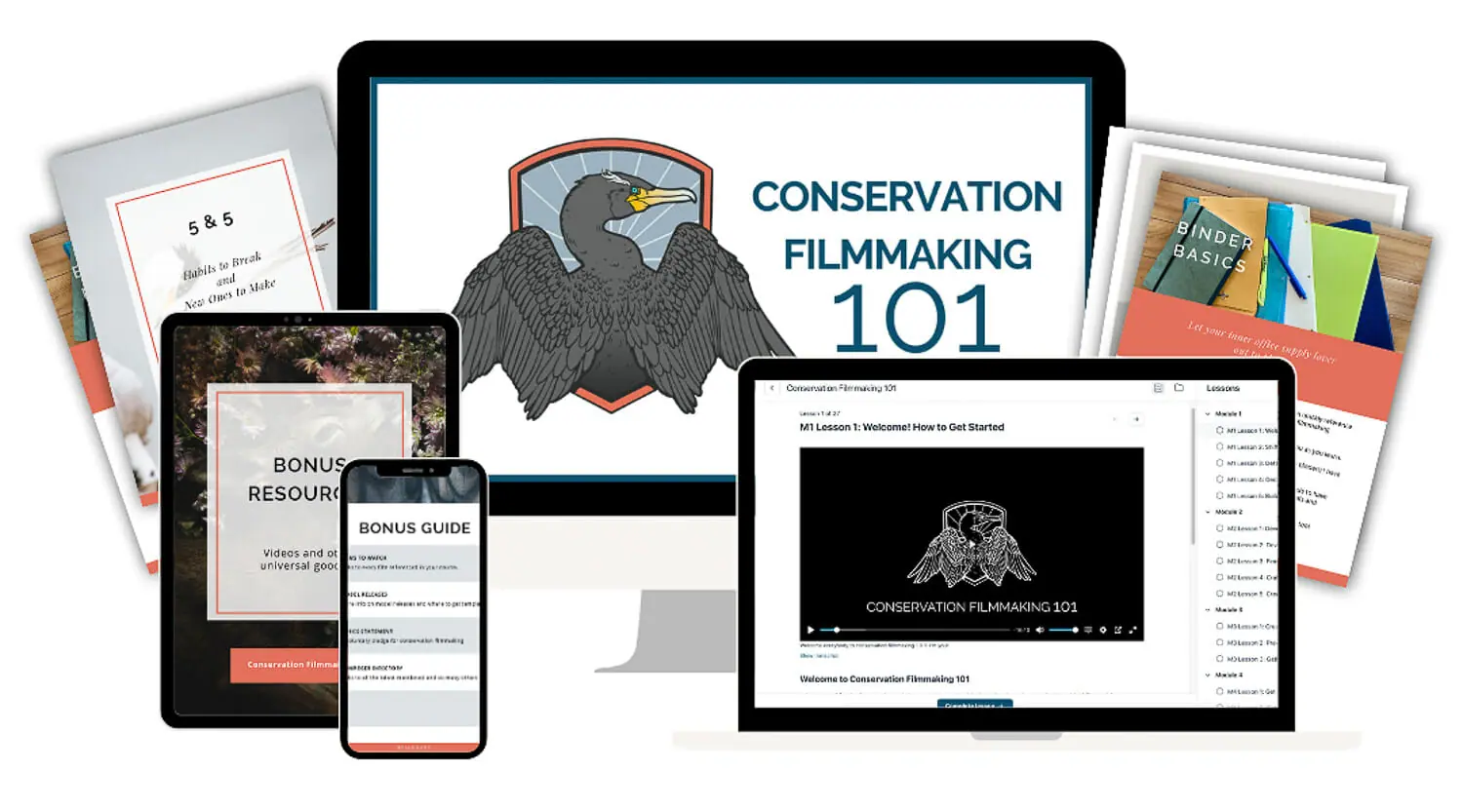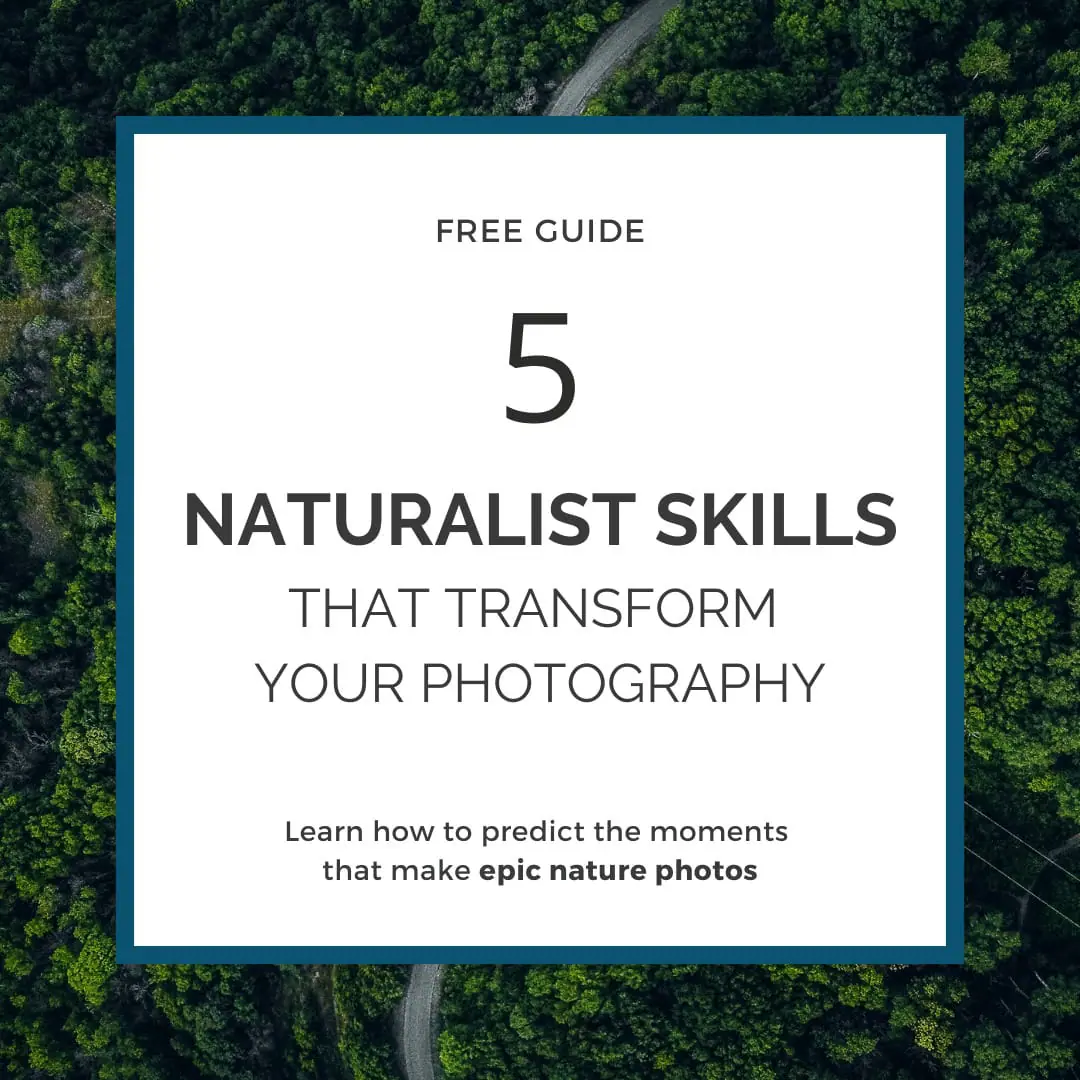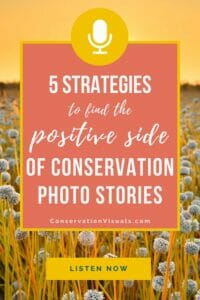5 Strategies to Find the Positive Angle In Every Conservation Photo Story
Training your brain to see the silver linings and solutions is essential in several ways, from engaging your audience to gaining the interest of editors.
Why solutions-oriented photo stories are important for conservation impact
There is a lot of sour and dour news out there, coming at us on a daily basis. For conservation photographers, that’s mostly what we deal in. It is our job to address the bad, and spark movement toward the good.
And there’s the key.
Sparking movement toward the good – that all-important positive change – means finding the silver lining in every story. It’s an essential step in crafting a narrative that will both wake up an audience and inspire action.
In fact, having a positive angle to a story is beneficial in several ways, including your story and audience as well as your mind and your bank account.
As bad news batters us, we can easily build up walls to protect ourselves from the overwhelm and loss of hope. It’s all too easy to just shrug and think, “Well everything is going to pot so what difference would I possibly be able to make?”
But that loss of hope, and loss of understanding our own individual power, is as great a threat to a sustainable future as the direct impacts of pollution, habitat destruction, species extinction and all the rest.
As conservation visual storytellers, not only do we have to show the realities of what is happening, but it is also very much within our ability – and indeed our responsibility – to show our viewers what their best next step is for action.
Finding that positive spin to your story helps move people from the problem to the solution, and inspires their action. And goodness knows we need everyone to take action on many issues.
The 5 strategies we cover in this episode
1. Find the “so what” for the audience
Why does this conservation issue matter to your audience member? Be careful that you're going beyond why you think it should matter to them.
2. Plan the call to action for the audience
What can someone do about the issue? If you know how the issue affects them, you can more easily identify the high quality actions your audience can take so they can avoid those negative impacts.
3. Image what a solution looks like and reverse engineer productive actions or event that get to that solution
If you’re struggling to see how your issue affects any audience, take a step back and just think about what your own ideal solution would look like. Start with the perfect ending, then build a map to get there.
4. Connect your story to broader positive aspect of the species, location, or activity that you're documenting
If you're zeroed in on one particular thing, and that happens to be a bummer of a story, then look for ways to expand out and connect that particular thing to a larger context that does have some positive angles.
5. Find precedent for success that can be used as an example for where your conservation issue could also find success
An incredible amount of hope can be found in seeing where there has been similar success elsewhere. Seeing the possibilities actually playing out inspires incredible amounts of hope – and this strategy helps fuel answers to all the previous strategies as well.
Episode 067: 5 Strategies to Find the Positive Angle In Every Conservation Photo Story
Shownotes: ConservationVisuals.com/67
(Digitally transcribed, please forgive any typos)
Digitally transcribed, please forgive any typos.
________________
Jaymi Heimbuch:
If you've been watching the news pretty much at all over the past couple months, then you know that there's a lot about news coming at us from all angles every day. But for conservation photographers, we're kind of used to that, right? I mean, it's essentially what we deal in. We are wired to see what's going on in the world that needs fixing, and we use our visual storytelling abilities to help fix it. It's our job to address the bad and to spark movement toward the good.
And that's really key, sparking movement toward the good. That all important positive change means finding the silver lining in every story we work on in every story. We're looking for the solutions. It's an essential step in crafting a narrative that will both wake up on audience and inspire action from that audience. And in fact, having a positive angle to a story is beneficial in a lot of ways. It helps you out as the conservation photographer who really needs to be able to see why they're working on a story to really embrace the positive side of why they're working on an issue and it helps your audience as well, and it helps your ability to even get your story out into the world. So having that ability to see solutions to see a silver lining it's critical stuff, right? So in this episode, I am going to talk about five strategies that you can use to find that silver lining to find those solutions so that you and everyone else can benefit to the max from each and every conservation photo story that you work on. Let's dive in.
Welcome to Impact the conservation photography podcast. I'm your host, Jaymi Heimbuch. And if you are a visual storyteller with a love for all things wild, then you're in the right place, from conservation to creativity, from business to marketing and everything in between. This podcast is for you, conservation visual storyteller who is ready to make impact. Let's dive in
About six months ago or so I wrote an article on this topic, and recently I was reminded of just how important this topic is this ability to find the silver lining of the solution in every story. Steven Bedard is the editor in chief of bioGraphic, one thing that he mentioned that made this concept really stand out is why he rejects certain pitches for bioGraphic. See, bioGraphic focuses on conservation stories, but they only accept stories that have a solution or a path forward built in. They pass on stories, they're just straight up bad news. And they accept stories that might be, you know, tough and raw and a worrying issue as long as there is some sort of path forward or toward a solution held within it.
So being reminded again that not only is this something that's important for us as photographers who really deal in tough issues all the time, it's important for us to really see silver linings to spare our ability to continue on with documenting those rough stories. It's really important for us in order to even get our stories out into the world, because that's what editors are looking for. So again, finding a silver lining is a big deal for your mind and your heart.
As a conservation photographer who is working continuously on potentially really tough issues, it's also important for your audience, and it's important for your chances of publication. bioGraphic is certainly not the only publication out there that is really seeking out stories that have solutions that are more than just bad news. So I'm digging into five strategies that you can use toe. Find that silver lining in any story that you're working on and really highlight that
Before we dive in. I need to take a moment to express some gratitude. See, this podcast is a couple of months old now, and in that time amazing listeners have been leaving five star ratings. And what's even more encouraging is you're leaving reviews. See, I don't know who is listening when I roll out an episode, and I kind of rely on those ratings and reviews to make sure that the episodes are helpful, that it's really reaching anyone. So I want to give a shout out to one of my reviewers. This comes in from Dan from Cohasset, who says, "My favorite podcast .whenever I'm in need of inspiration, entertainment or instruction. I listen to this podcast. The content is very rich, and Jaymi is a master of delivering it in a well organized and fun way. I look forward to each weekly installment, and I'm always excited to put into practice the strategies and tactics discussed in the podcast."
Thank you so much, Dan, from Cohasset for leaving this review. It means everything to me to know that not only are you listening and you're enjoying the information, but you're actually putting it into action That is so huge, and I really appreciate it. So if you are inspired or encouraged by this podcast like Dan, then please consider leaving a rating or review because seeing them really reinforces my energy behind creating these episodes. And I'm so inspired and motivated what I know that it is helpful information getting out and into your hands.
All right, so let's go ahead and dive into these five strategies, and we're gonna actually start off with talking about why a positive spin helps your story and your audience. So as bad news comes in and it really batters us and we're just hit again and again and again by a tough stories. We can really easily build up walls to protect ourselves from all of the overwhelm and the loss of hope that can happen when that's going on and on and on. And my goodness, we all know what this feels like. Lately with COVID-19 you've probably noticed yourself doing this now and again, as so much rough news comes in every single day. As we deal with a global pandemic, and especially when it comes to environmental stories, it could be all too easy to just shrug and think, Well, you know, everything's going to pot anyway. So what difference could I possibly be able to make? But that loss of hope and that loss of understanding our own individual power that is as great a threat to a sustainable future as the direct impact of pollution and habitat destruction and species extinction and all the rest as conservation visual storytellers? Not only do we have to show the realities of what is happening, but it is also very much within our ability, and I mean frankly, it's our responsibility to show our viewers what their next best step is for action.
It's one thing to document what is. And it's another thing to document what is and highlight what could be, and especially right now, when we have a global pandemic upon us that stemmed from our rocky relationship with the natural world with our habitat destruction and our wildlife trafficking. It is our job as conservation visual storytellers to help point people toward hope towards solutions that can right the ship. Finding that positive spin to your story helps move people from the problem to the solution, and it inspires their action. And goodness knows, we need everyone to take action on many issues right now.
It's also important to talk about why a positive spin helps your mind us a conservation photographer. See compassion. Fatigue is a very, very really thing, and luckily there is a growing acknowledgment of its existence and its effects. So if you haven't heard of compassion fatigue before, it's basically what happens when you spend a lot of time dealing with people or animals in distress. That focus can cause extreme tension inside of you and even a preoccupation with the plight of those that you're trying to help. So much so that you actually experience your own trauma from it. Those who suffer from compassion fatigue can have a range of symptoms. It can range from isolation to really high levels of stress and anxiety to insomnia to fatigue. It can be incredibly counterproductive to you as a conservation visual storyteller, but by training your brain to find the hopeful spots, the potential avenues for change the paths to get there and if you can find examples of success, is that serve as precedent to the improvements that you want to make on the issue that you're documenting. Well, then you have very strong and useful tools to stave off compassion, fatigue.
So your ability to really zero in on those bright spots of hope and, more importantly, up half toward hope. That's a huge part of being able to work inside of conservation photography on the long term and work on projects that are long term that can sometimes feel hopeless. You can keep focused on your why, on your solutions on your path forward and navigate your way through the tough moments and keep on that path.
Now it's also really important to talk about why a positive spin helps your bank account as a conservation visual storyteller because it's not just for the mental benefit of everyone to find the positive angles of a story, and that is, of course, very important. But it's also very important because it affects your ability to get your stories published. Like I said before, editors are more likely to turn down a bad news only story. But they might accept a bad news story that is wrapped up in hope for action. Why? Because it's easier to market.
I mean, editors know that if they continuously depress their readership, that readership is going to decline. Like if you knew that with every issue of a new magazine you got, you would be opening it up and be hit over the head with a bad news story with something that's tougher, awful, that's going on in the world, and you're never offered any way, too act on it or to see positive change, or to hope that there is a solution for this than would you really want to keep reading that magazine. My guess is you would probably decline your next subscription renewal and find something else, and editors know this. So if you as a conservation photographer can address an issue, and in the process, you can also help readers feel empowered or hopeful. Then they may take action. Or, in the very least, they're going to want to share the article with friends or family or followers. So the way that you approach a story is good for marketing that story. And editors want that kind of a story inside of their publications.
Now I want to be clear on one very important thing right now. Finding a positive angle for your story does not mean sugarcoating it. It does not mean making it overly Polly, Anna or rose colored glasses. It doesn't mean playing down the cold, hard truth of what your story is about. We're not letting anyone off the hook or allowing them tow wave off the gravity of a conservation situation. But what we are doing is both informing and inspiring action through hope. So with that in mind, let's get into five ways that you can train your brain to find that positive angle and find more success with your work and your stories.
So, strategy number one it is to find that So what factor for the audience So why does this conservation issue matter to your audience and be careful here that you are going beyond why you think it should matter to them? I mean, yes, of course. There is a reason why a conservation issue matters to the audience from a conservation perspective. But there's also a reason it matters to them. From their perspective. That might be how it impacts their families, health or their financial security or their shopping decisions, or even how it plays into what they know or understand about their political leaders. So with your story, how does your conservation issue impact your audience in a way that they really feel and recognize? Even if it's something that's happening on the other side of the world, how can you relate it back to what your audience is experiencing on a daily basis? Once you know this, then even if your conservation story impact is a negative one, you can find a positive way to frame the story, and you can do this in at least two ways.
So again, even if the conservation story that you're handling has a negative impact on your audience, you can reframe it into a positive spin. If you do one of two things first, you can future pace your audience and illustrate for them what it would look like if the negative impact were solved. So help paint a picture for your audience member. For if this negative impact is solved, this is what life would look like. Or you can future pace your audience and illustrate for them how taking action now will result in a positive change. So it's something that actually inspires them to be able to do something about whatever this negative impact is on their lives. So again, strategy Number one is figuring out the so what factor for the audience from their perspective. And then, even if your story has a negative impact, you can future pace your audience to show them either what it would look like if the negative impact were solved, which paints a more positive picture, right? Or you can future pace them to show how taking action now results in positive change. So you're almost taking them step by step into a positive change.
Now, Strategy number two is to plan the call to action for the audience. So what can someone do about the issue. If you know how the issue affect someone, which is something you can discover with strategy number one, then you can more easily identify the high quality actions that your audience contagious so that they can avoid those negative impacts. Once you identify at least one action, then you are well on your way for creating hope, because few things inspire hope, like knowing that you have the power within yourself to do something effective. That is, a huge part of being an effective storyteller. Is showing someone what they have the power to do to fix something Action ability is a positive in and of itself. So find at least one thing that a viewer can d'oh after they read your story or view your images. That makes a difference on the conservation issue. And be sure to highlight that.
So strategy number one is figure out a so what factor for the audience from their perspective strategy Number two is to figure out a call to action for the audience so that they feel empowered toe act to do something about the conservation issue strategy Number three is. Imagine what a solution looks like and then reverse engineer productive actions or an event that will get you to that solution. So let's say that you can't really figure out strategy number one or strategy number two. Well, then strategy number three is to figure out okay, if this conservation issue were solved, what would need toe happen in order to get to that solution? So spend some time really picturing the perfect version of the issue that you would like to see happen. And once you can envision what that ideal situation looks like, you can reverse engineer the actions that it takes to get there. So if you can see your goal, then can you see what action had to be taken to get to that goal? Will call that step a while in order to take step, eh? Step be needed to happen, right? And then well, in order for step, be to have happened step, see, needed to happen. So you're starting with that perfect ending and working backward. And in that practice building amount after you have a series of possible actions involved to get you to that ideal situation, well, then you can go back to strategy number one and two and really figure out what is involved in those. So you've figured out a solution. You figured out a road map, and now you can go back and figure out OK, so this is how it's affecting the audience is there? So what factor? And this is with the action they can take. This is the most important call to action that will provide to the audience member. So strategy number three is really amazing if you are really feeling stock in other ways
Now, Strategy number four is to connect your story to a broader positive aspect of the conservation issue, whether that is the species, a location or an activity that you're documenting. If you are zeroed in on one particular thing and that happens to be kind of a bummer of a story, then look for ways to expand out and connect that kind of bummer of a story to a larger context that does have some positive angles. So, for example, let's say you are focused on shark finning and all of the massive decline of shark species worldwide due to the shark fin trade. Well, you can expand out a little bit and provide information about how the presence of sharks as an apex predator directly benefits the health of coral reefs. And since coral reefs house around 25% of ocean biodiversity, well, sharks air amazingly important animals. And you can then point out how places that have recognized this and have banned finning in order to promote shark biodiversity. For Coral Reeves, they've seen a bounce back of coral reefs themselves. So, yes, you are still focused on ending shark finning. But instead of just looking at this massive decline of shark species because of finning, you're actually bringing it out into a broader context of how important sharks are for coral reef ecosystems and that some countries have banned finning and seen positive results. And voila, a positive spin to that story angle.
So see the silver lining approach. It also helps to shape your so what factor and your energizing calls to action as well. Because as you expand out from the really narrow kind of depressing focus of your story and you expand out into positive elements of the story, then you're able to shape why people really care in a broader context. You confined more ways Why people should care, and you can find more ways for them to act. Now. This kind of leads me into strategy. Number five.
So strategy number four is connecting your story to a broader positive aspect of the issue. Whether it's your species or your location, your activity and strategy. Number five is defined precedent for success that can be used as an example for where your conservation issue could also find success. An incredible amount of hope can be found in seeing where there has been similar success elsewhere.
So research, if there's been successes elsewhere inside of your conservation issue that you can highlight as examples for potential success on your very specific conservation story. One great example of this is Isla Mujeres, near Cancun, Mexico, and they've really recognized how, instead of killing a shark and finning it, they can actually draw in tourist to snorkel with the sharks, and they make a sustainable living off of the ongoing life of that animal. Really amazing success stories about shark finning situations turned into shark ICO tourism, and so that's a great example of how a kind of dire situation or a dire conservation issue can be highlighted. as something that has a really positive path forward to solve the issue. And with the strategy, you can take a story that might depressed people or make them feel like they don't have the power to do anything about it and show them that people already have made significant changes. And it's possible to end shark finning for good globally. Pretty amazing, right?
So if you're conservation story revolved around shark finning or the loss of a species that could become a tourism draw, do you have a precedent for success around that behavior change and the economic change? And seeing the possibility is actually playing out inspires incredible amounts of hope. And what's great about this strategy is that since successes already exist, figuring out what a solution will look like for your conservation issue and coming up with the necessary action steps and getting an audience on board with the so what that matters to them and future pacing your audience so that they can see the potential if they take action a love that becomes a much easier task. So this is actually a very powerful strategy for figuring out a silver lining. You just look and see what other people have already done to find the silver lining in effect, the path forward and have actually taken that path. All the pieces then come together in one glorious, hope filled hole.
So again, let's talk about these five strategies. So the first strategy, kind of the most straightforward one, is to figure out the so what factor for the audience from their perspective. So really figure out why the conservation issue matters to them and then frame that in a positive way. Why acting on the issue will be so helpful to them, or by showing them kind of what it looks like for them. If this negative issue were solved, Strategy Number two is planning out a call to action for the audience by showing them exactly what their one next step is that they should take you. Empower them toe act, and that feeling of empowerment provides a really positive vibe to your story. Overall strategy Number three is to imagine what a solution looks like and then reverse engineer the productive actions that you need to take to get to that solution. So if you're feeling really stock, then really the envision if you have the most perfect solution. If you're conservation is you were totally solved. What does that look like? And then reverse engineer a road map to that solution and inside of building out that road map, you'll also probably figure out the so what factor for the audience and their next call to action and strategy. Number four is. Connect your story to a broader positive aspect of either your species or your location or your activity. They're documenting inside your story. So even if your story is kind of at its heart, very depressing. If you can kind of pan out from that core relatively bummer of a story and connect it to other positive aspects, then you can reframe your story and be able to in a kind of literal way. Have a silver lining around it. And strategy number five is to find a precedent for success that can be used, in example, for where your own conservation issue could also find success. So this could be something that is really directly related to your conservation issue. Or it can be something where a similar conservation issue our story found success and that you can parallel that to your own and use it as an example.
All right, I hope that this was helpful and hopeful, and I will talk to you next week
Before we wrap up. I would love to ask you to do one quick thing. Subscribe to this podcast As a subscriber, you'll not only know when each week's episode of those lives, but you'll also get insider goodies like bonus episodes. You might miss them unless you're subscribed and I don't want you to miss out on a thing. So he's tapped that subscribe button, and I will talk to you next week.
________________
Impact: The Conservation Photography Podcast
JaymiHeimbuch.com/Podcast
